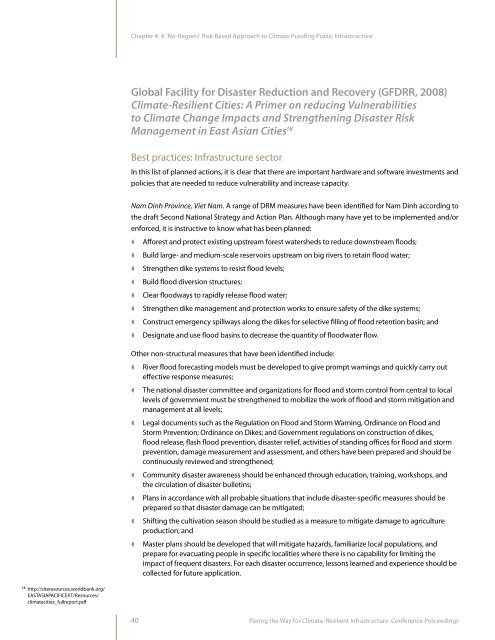Paving the Way for Climate-Resilient Infrastructure - UN CC:Learn
Paving the Way for Climate-Resilient Infrastructure - UN CC:Learn
Paving the Way for Climate-Resilient Infrastructure - UN CC:Learn
Create successful ePaper yourself
Turn your PDF publications into a flip-book with our unique Google optimized e-Paper software.
Chapter 4: A ‘No-Regrets’ Risk-Based Approach to <strong>Climate</strong> Proofing Public <strong>Infrastructure</strong>Global Facility <strong>for</strong> Disaster Reduction and Recovery (GFDRR, 2008)<strong>Climate</strong>-<strong>Resilient</strong> Cities: A Primer on reducing Vulnerabilitiesto <strong>Climate</strong> Change Impacts and Streng<strong>the</strong>ning Disaster RiskManagement in East Asian Cities 18Best practices: <strong>Infrastructure</strong> sectorIn this list of planned actions, it is clear that <strong>the</strong>re are important hardware and software investments andpolicies that are needed to reduce vulnerability and increase capacity.Nam Dinh Province, Viet Nam. A range of DRM measures have been identified <strong>for</strong> Nam Dinh according to<strong>the</strong> draft Second National Strategy and Action Plan. Although many have yet to be implemented and/oren<strong>for</strong>ced, it is instructive to know what has been planned:Af<strong>for</strong>est and protect existing upstream <strong>for</strong>est watersheds to reduce downstream floods;Build large- and medium-scale reservoirs upstream on big rivers to retain flood water;Streng<strong>the</strong>n dike systems to resist flood levels;Build flood diversion structures;Clear floodways to rapidly release flood water;Streng<strong>the</strong>n dike management and protection works to ensure safety of <strong>the</strong> dike systems;Construct emergency spillways along <strong>the</strong> dikes <strong>for</strong> selective filling of flood retention basin; andDesignate and use flood basins to decrease <strong>the</strong> quantity of floodwater flow.O<strong>the</strong>r non-structural measures that have been identified include:River flood <strong>for</strong>ecasting models must be developed to give prompt warnings and quickly carry outeffective response measures;The national disaster committee and organizations <strong>for</strong> flood and storm control from central to locallevels of government must be streng<strong>the</strong>ned to mobilize <strong>the</strong> work of flood and storm mitigation andmanagement at all levels;Legal documents such as <strong>the</strong> Regulation on Flood and Storm Warning, Ordinance on Flood andStorm Prevention; Ordinance on Dikes; and Government regulations on construction of dikes,flood release, flash flood prevention, disaster relief, activities of standing offices <strong>for</strong> flood and stormprevention, damage measurement and assessment, and o<strong>the</strong>rs have been prepared and should becontinuously reviewed and streng<strong>the</strong>ned;Community disaster awareness should be enhanced through education, training, workshops, and<strong>the</strong> circulation of disaster bulletins;Plans in accordance with all probable situations that include disaster-specific measures should beprepared so that disaster damage can be mitigated;Shifting <strong>the</strong> cultivation season should be studied as a measure to mitigate damage to agricultureproduction; andMaster plans should be developed that will mitigate hazards, familiarize local populations, andprepare <strong>for</strong> evacuating people in specific localities where <strong>the</strong>re is no capability <strong>for</strong> limiting <strong>the</strong>impact of frequent disasters. For each disaster occurrence, lessons learned and experience should becollected <strong>for</strong> future application.18http://siteresources.worldbank.org/EASTASIAPACIFICEXT/Resources/climatecities_fullreport.pdf40<strong>Paving</strong> <strong>the</strong> <strong>Way</strong> <strong>for</strong> <strong>Climate</strong>-<strong>Resilient</strong> <strong>Infrastructure</strong>: Conference Proceedings
















